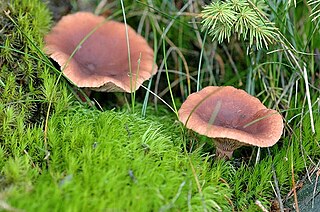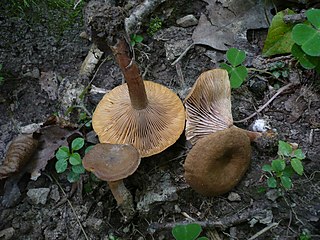| Lactarius crocatus | |
|---|---|
| Scientific classification | |
| Kingdom: | |
| Division: | |
| Class: | |
| Order: | |
| Family: | |
| Genus: | |
| Species: | L. crocatus |
| Binomial name | |
| Lactarius crocatus Van de Putte & Verbeken (2010) | |
Lactarius crocatus is a member of the large milk-cap genus Lactarius in the order Russulales. Found in Chiang Mai Province (northern Thailand), it was described as new to science in 2010. [1]

The Russulales are an order of the Agaricomycetes,. According to the Dictionary of the Fungi, the order consists of 12 families, 80 genera, and 1767 species. According to Species Fungorum, the order contains 13 families, 117 genera, and 3,060 species.

The Russulaceae are a diverse family of fungi in the order Russulales, with roughly 1,900 known species and a worldwide distribution. They comprise the brittlegills and the milk-caps, well-known mushroom-forming fungi that include some edible species. These gilled mushrooms are characterised by the brittle flesh of their fruitbodies.

Lactarius is a genus of mushroom-producing, ectomycorrhizal fungi, containing several edible species. The species of the genus, commonly known as milk-caps, are characterized by the milky fluid ("latex") they exude when cut or damaged. Like the closely related genus Russula, their flesh has a distinctive brittle consistency. It is a large genus with over 500 known species, mainly distributed in the Northern hemisphere. Recently, the genus Lactifluus has been separated from Lactarius based on molecular phylogenetic evidence.

Candy cap or curry milkcap is the English-language common name for several closely related edible species of Lactarius; L. camphoratus, L. fragilis, and L. rubidus. These mushrooms are valued for their highly aromatic qualities and are used culinarily as a flavoring rather than as a constituent of a full meal.

Lactifluus volemus, formerly known as Lactarius volemus, is a species of fungus in the family Russulaceae. It is widely distributed in the northern hemisphere, in temperate regions of Europe, North America and Asia as well as some subtropical and tropical regions of Central America and Asia. A mycorrhizal fungus, its fruit bodies grow on the ground at the base of various species of trees from summer to autumn, either individually or in groups. It is valued as an edible mushroom, and is sold in markets in Asia. Several other Lactifluus mushrooms resemble L. volemus, such as the closely related edible species L. corrugis, but these can be distinguished by differences in distribution, visible morphology, and microscopic characteristics. L. volemus produces a white spore print and has roughly spherical spores about 7–8 micrometres in diameter.

Multifurca is a rare genus of ectomycorrhizal fungi in the family Russulaceae. It was described in 2008, after molecular phylogenetic study had shown that it forms a monophyletic lineage within the family, sister to Lactarius. The genus contains six species known from the United States, Mexico, Costa Rica, India, China, Thailand, Australia, and New Caledonia, but so far has not been reported from Europe, Africa, or South America. Four of those species were formerly classified as Russula section Ochricompactae, and Multifurca furcata was originally described as a Lactarius species.

Lactarius lignyotus is a member of the large milk-cap genus Lactarius in the order Russulales. It was first described scientifically by Elias Magnus Fries in 1855. It is considered edible, but of little interest.
Lactarius lamprocystidiatus is a member of the large milk-cap genus Lactarius in the order Russulales. Found in Papua New Guinea, it was first described scientifically by Verbeken and Horak in 2000.

Lactarius subumbonatus is a member of the large milk-cap genus Lactarius in the order Russulales. It was first described scientifically by Sven Johan Lindgren in 1845.
Lactarius acicularis is a member of the large milk-cap genus Lactarius in the order Russulales. Described as new to science in 2010, the species is found in Chiang Mai Province of northern Thailand, where it grows in rainforests that are dominated by Castanopsis armata, Dipterocarpus sp. and Lithocarpus. The specific epithet, acicularis, is derived from Latin and means "needle-shaped".
Lactarius distantifolius is a member of the large milk-cap genus Lactarius in the order Russulales. Found in Chiang Mai Province, it was described as new to science in 2010. The fruit bodies of the fungus were found growing in a teak plantation with Dipterocarpus obtusifolius and other Dipterocarpus species, Pterocarpus macrocarpus, and Shorea species.
Lactarius longipilus is a member of the large milk-cap genus Lactarius in the order Russulales. Found in Chiang Mai Province, it was described as new to science in 2010. The mushrooms were found at an elevation of 1,300 metres (4,300 ft) growing in a forest dominated by Castanopsis spp., Lithocarpus sp., and Pinus kesiya.
Lactarius pinguis is a member of the large milk-cap genus Lactarius in the order Russulales. Found in northern Thailand, it was described as new to science in 2010.
Lactarius vitellinus is a member of the large milk-cap genus Lactarius in the order Russulales. Found in northern Thailand, it was described as new to science in 2010.
Lactarius torminosulus is a member of the large milk-cap genus Lactarius, in the order Russulales. A European species, it was officially described in 1996 from collections made in Norway. Fruit bodies (mushrooms) are small to medium-sized, yellowish orange in colour. Young specimens have a hairy cap margin; these hairs slough off in maturity—a field characteristic that can be used to help distinguish this species from the similar Lactarius torminosus. The fungus grows in a mycorrhizal association with dwarf birch species.
Multifurca furcata is a rare mushroom-forming fungus in the genus Multifurca. It was originally described as a Lactarius species in 1918 and was moved to the new genus Multifurca in 2008. With the genus Lactarius it shares the exudation of milk-like latex; however, it is microscopically and molecularly distinct. It has been found very infrequently, with currently known localities in the United States, Mexico, Costa Rica, and China.
Lactarius baliophaeus is a member of the large milk-cap genus Lactarius in the order Russulales. Described as new to science by mycologist David Pegler in 1969, the species is found in Ghana, Benin, and Zambia. Fruitbodies of the type collection were found growing in the ground under Cassia. It is closely related to Lactarius subbaliophaeus, a species described from Togo in 2014. Both are classified in Lactarius section Nigrescentes. L. baliophaeus is edible and used as food.
Lactarius subbaliophaeus is a member of the large milk-cap genus Lactarius in the order Russulales. Found in Togo, it was described as new to science in 2014 by Dao Lamèga Maba and Nourou Yorou. It is named for its similarity to the more widespread African species L. baliophaeus. L. subbaliophaeus produces a white latex which, upon exposure to air, changes color to pinkish and then blackish.